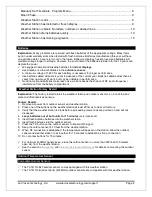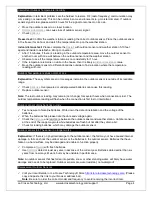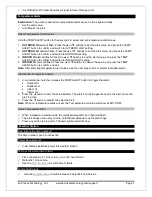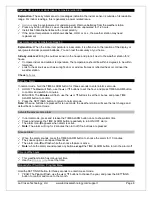
La Crosse Technology, Ltd. www.lacrossetechnology.com/support
Page 9
2. MONTH: The
Month
will flash, use the ▲ or ▼ buttons to choose the month, and press the
SETTINGS button to confirm and move to the date.
3. DATE: The
Date
will flash, use the ▲ or ▼ buttons to choose the date, and press the SETTINGS
button to confirm and move to 12/24 hour time.
4. 12/24-HOUR: The time format
12H
will flash, use the ▲ or ▼ buttons to choose 12-hour or 24-hour
time format and press the SETTINGS button to confirm and move to hour.
5. HOUR: The
Hour
will flash, use the ▲ or ▼ buttons to choose the hour, and press the SETTINGS
button to confirm and move to minutes.
6. MINUTES: The
Minutes
will flash, use the ▲ or ▼ buttons to choose the minutes, and press the
SETTINGS button to confirm and move to select Fahrenheit/Celsius.
7. FAHRENHEIT/CELSIUS:
°F or °C
will flash. Use the ▲ or ▼ buttons button to select Fahrenheit or
Celsius. Press and release the SETTINGS button to confirm and exit the program menu.
Note:
When no buttons are pressed for ten seconds, the weather station will save the last change and
default back to normal mode.
Moon Phase
Explanation:
The Moon Phase is based on the date manually set on the weather station. The moon is
divided by 6 sections, showing 12 phases of the moon.
Waxing
indicates growing or expanding illumination and happens after a new moon.
Waning
indicates decreasing illumination and occurs after a full moon.
Crescent
refers to the moon being less than half-illuminated. Crescents can be waning or waxing.
Gibbous
describes a moon phase when more than half is illuminated. Gibbous can be waxing or
waning.
New Moon
occurs when the moon is between the earth and sun, so the illuminated portion of the
moon is on the backside facing the sun and we cannot see it. After a new moon, the illuminated
portion will increase or wax until the full moon occurs.
Full Moon
occurs when the earth, moon and sun are in approximate alignment, with the moon and
the sun on opposite sides of the earth. The illuminated portion of the moon faces the earth, giving us
complete visibility of one side of the entire moon. After a full moon, the illuminated portion will
decrease or wane until the new moon occurs.
First Quarter
and
Last Quarter
moons occur when the moon is at a 90-degree angle to the earth
and sun. We see half of the moon illuminated and the other half is in shadow.
Weather Station is dim
Explanation:
Most weather stations have a gray background. Place the weather station at eye level, to
determine if it is dim. Weather stations that sit in the sunlight can develop a cloudy film over time.
This is generally a power related issue.
may be overpowered or underpowered. Remove batteries from weather station.
Press any button 20 times. Leave the weather station unpowered for 1-2 hours.
Install fresh alkaline batteries with correct polarity.
Weather Station has distorted or frozen display
Explanation:
On a brand new weather station, check for thin plastic film of
printed scratch guard
that
may be on the screen of the weather station. This thin piece of plastic has printed numbers for store
displays. When the batteries are installed, the “real” numbers show behind the printed scratch guard and
create distortion.
With all power removed, the weather station should be blank.
If numbers still appear, please check for scratch guard.
Power:
Check that the batteries are installed correctly.
This is generally a power related issue.
may be overpowered or underpowered.
Remove batteries from weather station.
Press any button 20 times. Leave the batteries out of the display for 2 hours.
Insert batteries into the weather station.










